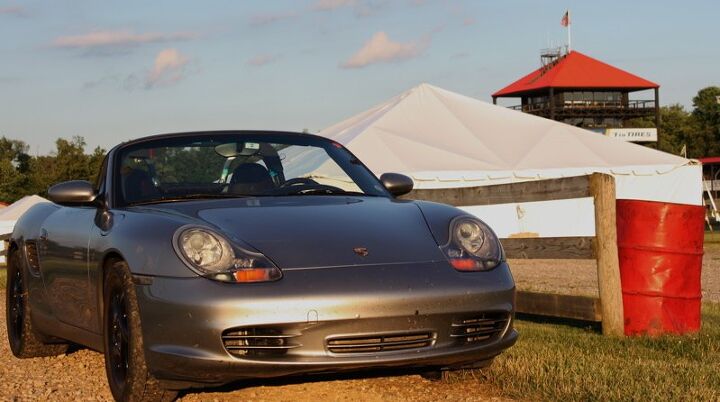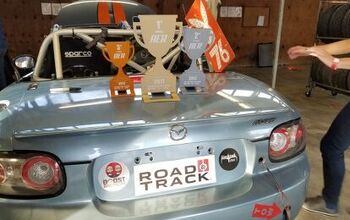Trackday Diaries: All by Myself.

For only $195, you can run a “twilight” session at Mid-Ohio on Wednesday evenings. Given that I wanted to turn respectable times in Thursday’s Grand-Am test day, it seemed like a no-brainer. Until, that is, my ride in the Continental Challenge fell through due to the unavailability of my co-driver. Since I’d already paid for the Wednesday, I loaded up, (with a set of Hoosier A3S05 autocross tires) headed out, and arrived on Wednesday night to find precisely three cars signed up for evening practice. Neither of the others (a track-prepped M3 and a Nissan GT-R) would be running quite at my pace, but they wouldn’t be far off it, so once I passed them I wouldn’t see them again for most of the session.
Driving around a track all by yourself is an interesting thing to do, particularly if you honor the request of the Mid-Ohio School and do not directly time your laps. How do you know if you’re doing well? How do you determine how hard to push? And when you see a Viper come in on the flatbed right before your session with the rear end basically torn off (I have photos, but I want to protect the driver’s privacy), what does that do to your mindset? As it turns out, there’s another situation which is very similar to this one: amateur endurance racing.
Every racer can point to one drive and say “That was my best.” For me, it was a NASA enduro I ran at Mid-Ohio last year. I elected to drive by myself for the ninety-minute race (most endurance teams are two-driver affairs) and led my nineteen-car class from the first corner to the pitstop, where I fell about two minutes behind the leaders. (This ain’t Formula One; pitstops are slow in amateur racing, and I had a car without a quick-fuel rig.) I came out and methodically made up the time, regaining the lead with about twenty laps to go. Ten laps from the finish, I started to run out of fuel. I drove the whole track in fifth gear, stalling briefly in every right-hander, while the second-place driver made up the gap. I crossed the line with the second-place guy about a hundred yards back. Not only was my 1989 Honda Civic first in my “E2” class, I was also fourth overall, ahead of Porsches, Corvettes, and one particularly incompetent, loud-mouthed hack in an SCCA Touring 2 Mustang.
For the vast majority of that race, I had no drivers in my class around me to judge my performance. I also didn’t have a working lap timer because said lap timer had been installed in the team’s other Civic. Still, I turned fast lap for the class. How did I do it?
Reaching a so-called “9/10ths” lap without timing equipment isn’t that tough. If you are driving in the “sing” zone of your tires through every turn (I’ll write more about the “sing” zone of tires in the future) and you are consistently braking as late as possible, you’re pretty much there. Ross Bentley tells us that a driver operating the car close to the limits slightly “off-line” will be faster than a car that is “on-line” but being driven well below the limit. So we don’t even have to get right on the proper line to hustle.
There are certain warning signs that we are approaching the fabled “tenth tenth”. If the car has to be fought all the way through the brake zone, you’re on your way. If you are making fingertip-sized corrections with the wheel to arrest oversteer in the midcorner, while applying constant throttle on a reasonably proper line, you are on the way. If your exit carries you to within an inch of the grass on the exit, and you couldn’t change the course of the car for love or money because you were at max speed all the way through and max power on the exit, chances are you are there.
I know that I am on pace when I feel lucky to escape each corner. At Mid-Ohio, Turns One and Eleven are the “lucky” turns. If you drift to the corner of the dirt where the service road meets the back straight at the exit of One, you’re doing the business. If the light touch of the curb right where it ends at the end of Eleven keeps you from going into the grass, you’re on pace.
I hadn’t been at Mid-Ohio for a while, and I didn’t feel much like wrecking my precious little Boxster, but once I realized that there were people from various Continental Challenge teams just sitting out enjoying the evening and watching the track, I forgot any notion of taking it easy. I watched my revs at corner exit (a good way to understand your relative pace when you have no timing equipment) and kept adding fifty or a hundred spins. The good-natured Porsche became progressively more annoyed with Turn Eleven, finally biting me with a bit of a slide and half a tire width’s worth of turf collection. Now we’re doing something.
I had to quit the evening early because my tires were shot, but I felt pretty good. I knew I’d done some good times, and it didn’t matter to me. Really, it didn’t. I saw someone I knew. He said, “I had my stopwatch and…”
“PLEASE TELL ME,” I said, before he could tell me. So much for quiet satisfaction. Turns out he wasn’t timing me. He was timing the other cars. After some discussion about the gaps between me and the other cars, we figured out that I was running somewhere between 1:44 and 1:45 on the Club Course. That’s good enough to win Time Trial C — the Boxster’s natural habitat — on most weekends.
The moral of the story? When you think you’re hustling, chances are that you are hustling. Some drivers can get into a zone where they are driving quickly without being conscious of it. I envy those folks. For the rest of us, going fast means fighting for every inch on the racetrack, every time.

More by Jack Baruth
Latest Car Reviews
Read moreLatest Product Reviews
Read moreRecent Comments
- Lou_BC "That’s expensive for a midsize pickup" All of the "offroad" midsize trucks fall in that 65k USD range. The ZR2 is probably the cheapest ( without Bison option).
- Lou_BC There are a few in my town. They come out on sunny days. I'd rather spend $29k on a square body Chevy
- Lou_BC I had a 2010 Ford F150 and 2010 Toyota Sienna. The F150 went through 3 sets of brakes and Sienna 2 sets. Similar mileage and 10 year span.4 sets tires on F150. Truck needed a set of rear shocks and front axle seals. The solenoid in the T-case was replaced under warranty. I replaced a "blend door motor" on heater. Sienna needed a water pump and heater blower both on warranty. One TSB then recall on spare tire cable. Has a limp mode due to an engine sensor failure. At 11 years old I had to replace clutch pack in rear diff F150. My ZR2 diesel at 55,000 km. Needs new tires. Duratrac's worn and chewed up. Needed front end alignment (1st time ever on any truck I've owned).Rear brakes worn out. Left pads were to metal. Chevy rear brakes don't like offroad. Weird "inside out" dents in a few spots rear fenders. Typically GM can't really build an offroad truck issue. They won't warranty. Has fender-well liners. Tore off one rear shock protector. Was cheaper to order from GM warehouse through parts supplier than through Chevy dealer. Lots of squeaks and rattles. Infotainment has crashed a few times. Seat heater modual was on recall. One of those post sale retrofit.Local dealer is horrific. If my son can't service or repair it, I'll drive 120 km to the next town. 1st and last Chevy. Love the drivetrain and suspension. Fit and finish mediocre. Dealer sucks.
- MaintenanceCosts You expect everything on Amazon and eBay to be fake, but it's a shame to see fake stuff on Summit Racing. Glad they pulled it.
- SCE to AUX 08 Rabbit (college car, 128k miles): Everything is expensive and difficult to repair. Bought it several years ago as a favor to a friend leaving the country. I outsourced the clutch ($1200), but I did all other work. Ignition switch, all calipers, pads, rotors, A/C compressor, blower fan, cooling fan, plugs and coils, belts and tensioners, 3 flat tires (nails), and on and on.19 Ioniq EV (66k miles): 12V battery, wipers, 1 set of tires, cabin air filter, new pads and rotors at 15k miles since the factory ones wore funny, 1 qt of reduction gear oil. Insurance is cheap. It costs me nearly nothing to drive it.22 Santa Fe (22k miles): Nothing yet, except oil changes. I dread having to buy tires.


































Comments
Join the conversation
As I recall from reading about professional rallies in my 1960's youth, it was said that most rally drivers started out at 60-70% and pushed it up to 90-95%. The crazyeffinbastid Finns would start out at 90% and push on up....to crash and burn.
Good read. I hope to see you in the Continental Challenge again sometime. I've been watching on Speed since I heard about the series through meeting Billy Johnson at Bondurant a couple of months ago. Good racing.